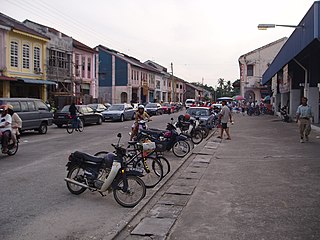
Perak is a state of Malaysia on the west coast of the Malay Peninsula. Perak has land borders with the Malaysian states of Kedah to the north, Penang to the northwest, Kelantan and Pahang to the east, and Selangor to the south. Thailand's Yala and Narathiwat provinces both lie to the northeast. Perak's capital city, Ipoh, was known historically for its tin-mining activities until the price of the metal dropped, severely affecting the state's economy. The royal capital remains Kuala Kangsar, where the palace of the Sultan of Perak is located. As of 2018, the state's population was 2,500,000. Perak has diverse tropical rainforests and an equatorial climate. The state's mountain ranges belong to the Titiwangsa Range, which is part of the larger Tenasserim Range connecting Thailand, Myanmar and Malaysia. Perak's Mount Korbu is the highest point of the range.

Ipoh is the capital city of the Malaysian state of Perak. Located by the Kinta River, it is nearly 180 km (110 mi) north of Kuala Lumpur and 123 km (76 mi) southeast of George Town in neighbouring Penang. As of 2010, Ipoh had a population of 657,892, making it the fourth largest city in Malaysia by population.

Teronoh is a small tin-mining town in Kinta District, Perak, Malaysia.

Taiping is a town located in Larut, Matang and Selama District, Perak, Malaysia. It is located approximately 48 km (30 mi) northwest of Ipoh, the capital of Perak, and 78 km (48 mi) southeast of George Town, Penang. With a population of 245,182, it is the second largest town in Perak after Ipoh, the state capital.

Kellie's Castle is a castle located in Batu Gajah, Kinta District, Perak, Malaysia. The unfinished, ruined mansion, was built by a Scottish planter named William Kellie-Smith. According to differing accounts, it was either a gift for his wife or a home for his son. Kellie's Castle is situated beside the Raya River, which is a small creek to the Kinta River.

The Kinta District is a district in Perak, Malaysia. It contains the state capital Ipoh.

Kinta River is a river in Perak, Malaysia. It gets its name from the Kinta Valley, which surrounds Ipoh, the capital of Perak. Ipoh sits along this river. There are many limestone hills in the area surrounding the river, and there used to be many tin mines. The supposedly largest tin field in the world was discovered in 1876 in the Kinta Valley. The river was also well known for its wide variety of freshwater fish. The fisheries department reported a greater abundance of fish from the Intake Dam to Tasek, and from a secluded fish pool, 0.75 miles (1.21 km) down from Tanjung Rambutan. Fishing in this area used to be a major local activity until the fisheries gradually closed down.
Tanjung Tualang is a mukim in Kinta District, Perak, Malaysia.

Jean-Jacques de Morgan was a French mining engineer, geologist, and archaeologist. He was the director of antiquities in Egypt during the 19th century, and excavated in Memphis and Dashur, providing many drawings of many Egyptian pyramids. He also worked at Stonehenge, and Persepolis, and many other sites.

Leong Fee is the Hakka name for Liang Pi Joo (1857–1912), a worker from Guangdong in China who emigrated to Malaya in 1876.
Leong Sin Nam 梁燊南, alias Leong Sin, Leung Sin, Leong Sin Hee, was a Malaysian businessman. He migrated and settled in British Malaya in 1898. From humble beginnings, he worked hard to become a wealthy tin mine owner in Perak. He was a businessman, an active community leader and a philanthropist. He was a Chinese revolutionary with similar aspirations as Dr. Sun Yat Sen and a strong supporter of the Chinese war efforts during the Sino-Japanese war.

The Kinta Valley is a conurbation in central Perak, Malaysia, surrounding and including the state capital Ipoh. Historically the Kinta Valley was very rich in tin, and their mines have been among the most productive in the world. The valley is formed by the Kinta River, a tributary of Sungai Perak, which flows between the Main Range and the Kledang Range. It forms the largest tin field along the Siamese-Malayan peninsula tin belt. It has been mined since ancient times by indigenous peoples but more intensively mined by the Chinese and Europeans since the end of the nineteenth century. Today, the modern Kinta district is one of the ten administrative districts of Perak. In 2018, the valley was declared Malaysia's second national geopark.

Little India Ipoh, is one of the major business centers of Malaysian Indians in Ipoh, Perak, Malaysia.

Han Chin Pet Soo (闲真别墅) is Malaysia's first Hakka tin mining museum managed by Ipoh World Sdn. Bhd. Located on the edge of Ipoh's Old Town, close to the Kinta River. Within walking distance of the well-known Panglima Lane, it is the #1 attraction in Ipoh on TripAdvisor.

The Geological Museum is a museum in Ipoh, Kinta District, Perak, Malaysia.

Mining is one of the main industries in Malaysia. Malaysia produces aggregate, bauxite, clay, coal, copper, feldspar, gold, gravel, ilmenite, iron ore, kaolin, limestone, mica, monazite, sand, silica sand, struverite and tin.

The Tanjung Tualang Tin Dredge No. 5 (TT5) is a former tin mining dredge in Batu Gajah, Kinta District, Perak, Malaysia.

The Perak State Herb Park is a park in Batu Gajah, Kinta District, Perak, Malaysia.

The Darul Ridzuan Museum is a museum in Ipoh, Kinta District, Perak, Malaysia.

















